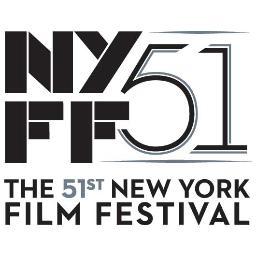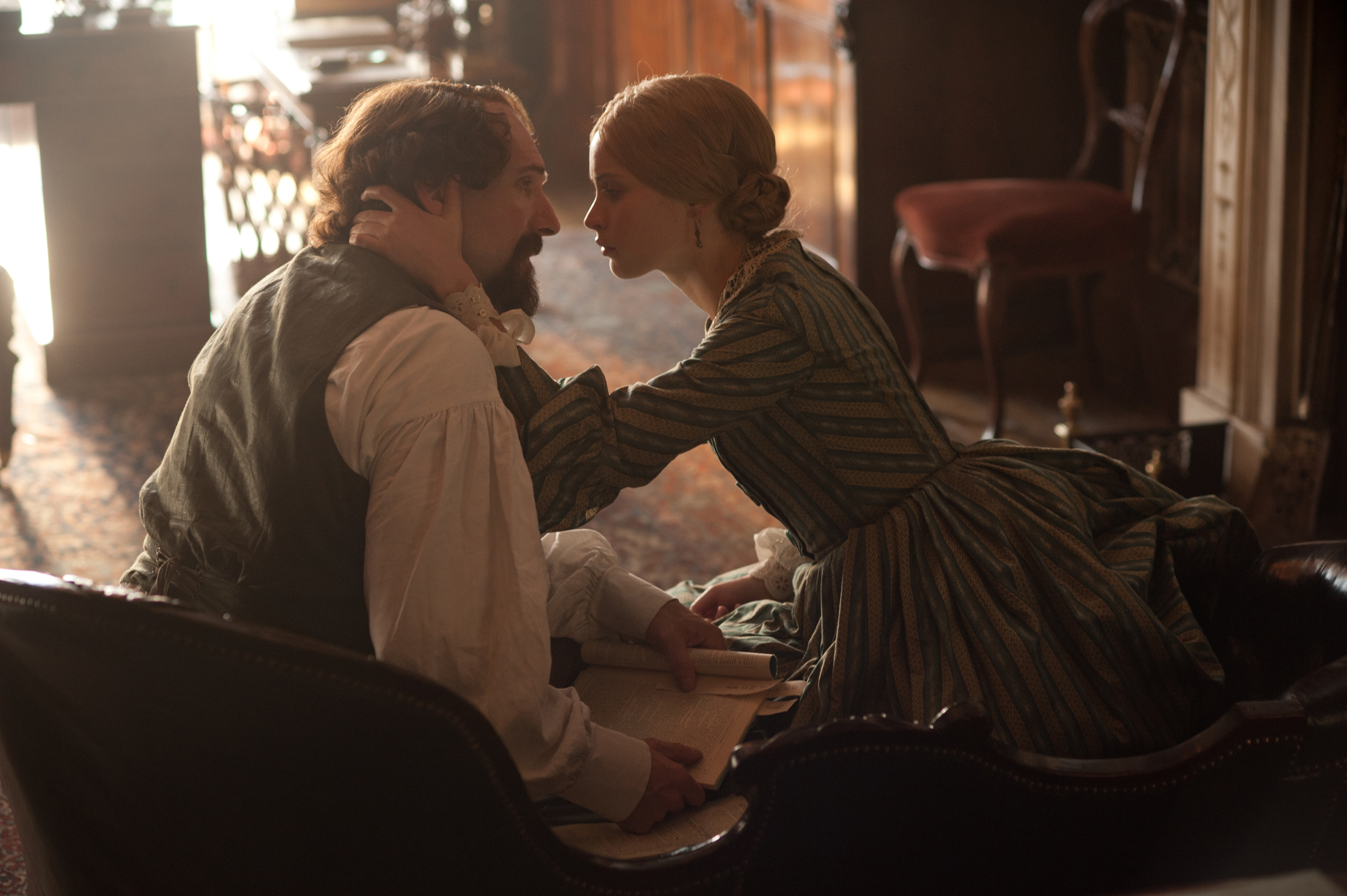NYFF51: Made for Each Other? [Part 4]
 “Lovers don’t meet out in the world; they are in each other from the start,” or so one Facebook philosopher puts it, summing up the essence of Hollywood love: a fantasy of perfect, eternal unity. It’s an attractive ideal that gratifies our longing for love that never fades, but movies often hide the dark side of such imagined perfection: its delusional, solipsistic projection of selfish needs. At NYFF51, Jim Jarmusch’s Only Lovers Left Alive and Ralph Fiennes’ The Invisible Woman blindly embrace the sexist fantasy version of the made-for-each-other ideal; while, with simplicity and grace, Spike Jonze’s HER puts an original, modern spin on the persistent, questionable Romantic desire for the my-dream-come-true intimate partner.
“Lovers don’t meet out in the world; they are in each other from the start,” or so one Facebook philosopher puts it, summing up the essence of Hollywood love: a fantasy of perfect, eternal unity. It’s an attractive ideal that gratifies our longing for love that never fades, but movies often hide the dark side of such imagined perfection: its delusional, solipsistic projection of selfish needs. At NYFF51, Jim Jarmusch’s Only Lovers Left Alive and Ralph Fiennes’ The Invisible Woman blindly embrace the sexist fantasy version of the made-for-each-other ideal; while, with simplicity and grace, Spike Jonze’s HER puts an original, modern spin on the persistent, questionable Romantic desire for the my-dream-come-true intimate partner.
 The best first. In HER, Joaquin Phoenix turns in a beautiful performance as Theodore, a lonely computer nerd, who yearns for the perfect other. He is not alone. In a gleaming Los Angeles landscape of plenty in the “near future,” all the characters, free of the need to scrape for the basic necessities, focus their attentions on achieving total bliss through love, but in vain. Material affluence has fostered commercially produced expressions of emotion; the adolescent craving that the beloved conform with every whim and caprice; and/or the unreasonable demand for an immediate guarantee of commitment. Theodore lives in a world of comfortable disconnection, earning an excellent living crafting “personal” letters for the many who have nothing to say to each other, which he too experiences in his own life.
The best first. In HER, Joaquin Phoenix turns in a beautiful performance as Theodore, a lonely computer nerd, who yearns for the perfect other. He is not alone. In a gleaming Los Angeles landscape of plenty in the “near future,” all the characters, free of the need to scrape for the basic necessities, focus their attentions on achieving total bliss through love, but in vain. Material affluence has fostered commercially produced expressions of emotion; the adolescent craving that the beloved conform with every whim and caprice; and/or the unreasonable demand for an immediate guarantee of commitment. Theodore lives in a world of comfortable disconnection, earning an excellent living crafting “personal” letters for the many who have nothing to say to each other, which he too experiences in his own life.
Enter the OS lover. As if in answer to Theodore’s deep need, a personal electric called the Operating System suddenly appears on the market, a computerized artificial intelligence that “listens, understands, and knows you” and can be of whatever gender you desire. Theodore orders the OS of his dreams, calls her Samantha (Scarlett Johansson’s voice), and experiences a bliss he has never previously known. “She” is literally made for him, and she continues to strive to be even better at her job. Soon, everyone has an OS and the streets are full of the formerly broken-hearted talking happily to their personal OS partners through white rubber earpieces that resemble Bluetooth gizmos. Indeed, existing marriages break up when people begin to feel that they pale in comparison with the satisfactions offered by the tailored-to-personal-preference OS.
It is unlikely that any first-time viewer will foresee what happens next, and the surprise is so exhilarating that revealing the ending would be criminal. Just let it be said that Theodore’s sinister reliance on technologically-generated intimacy does not lead to the demonizing of science or technology. Rather a wonderfully conceived plot twist yields a cathartic termination of Theodore’s narcissistic dependencies, as well as intimations of the limitless possibilities of the universe and even a potential experience of God, or whatever name you give to divinity. It is a thrillingly original film about love.
 By contrast, Only Lovers Left Alive and The Invisible Woman both lionize love connections that many may see as blatantly contaminated by outdated gender dynamics. Jarmusch’s Only Lovers Left Alive is about the eternal love of characters antically named Adam (Tom Hiddleston) and Eve (Tilda Swinton), literally eternal since they are vampires. The pair spend their undead time commuting between Detroit, where they have to deal with Eve’s obnoxious little sister vampire, Ava (Mia Wasikowska), and Tangier, where they rendezvous with Christopher Marlowe (John Hurt), the Renaissance playwright, also a vampire, who is still with us. They drink boutique blood acquired through money instead of fangs; commiserate about American boorishness; and soldier on, making do with first-class airplane seats until they lose their blood suppliers, and Marlowe dies. In the last frame, they lower themselves to using their fangs in order to keep love alive.
By contrast, Only Lovers Left Alive and The Invisible Woman both lionize love connections that many may see as blatantly contaminated by outdated gender dynamics. Jarmusch’s Only Lovers Left Alive is about the eternal love of characters antically named Adam (Tom Hiddleston) and Eve (Tilda Swinton), literally eternal since they are vampires. The pair spend their undead time commuting between Detroit, where they have to deal with Eve’s obnoxious little sister vampire, Ava (Mia Wasikowska), and Tangier, where they rendezvous with Christopher Marlowe (John Hurt), the Renaissance playwright, also a vampire, who is still with us. They drink boutique blood acquired through money instead of fangs; commiserate about American boorishness; and soldier on, making do with first-class airplane seats until they lose their blood suppliers, and Marlowe dies. In the last frame, they lower themselves to using their fangs in order to keep love alive.
Unlike Jarmusch’s last film, The Limits of Control, a brilliant meditation on time, space, and language, in which action is subordinated to frame composition, this is a sophomoric pastiche that mixes static and artful visuals with weakly comic allusions. Adam, in disguise, identifies himself as Dr. Faust to a blood supplier named Dr. Watson. When Ava is sickened by contaminated blood, Eve asks “What did you expect? He [Ava’s victim] was in the music industry.” Both vampire women are defined only by what they mean to the men, who are defined by their creativity. And all of them are parasites with a giant-sized contempt for ordinary life. Jarmusch expressed love for this project at his press conference, but can the man who directed such masterpieces as Dead Man and Ghost Dog really be excited by the denizens of these “cool,” claustrophobic sets, wearing wigs made out of human, goat, and yak hair, because Jarmusch wanted them to have a quality of animality? Some would say he ended up with taxidermy instead.
 Finally, Fiennes’ The Invisible Woman, based on Claire Tomalin’s biography of a backstreet affair between Ellen “Nelly” Ternan and Charles Dickens, uses Tomalin’s scholarly cache as an excuse for sprinkling stardust over aging men who discard their wives in favor of much younger women. Told in flashback, the film ostensibly honors Nelly’s decision to commit to her husband and child rather than the memory of her dead lover, Charles Dickens. However, because Fiennes sets the screen on fire with the bogus perfection of Dickens (Ralph Fiennes) and Ternan (Felicity Jones), and because Ternan never tells her husband about her secret romance, her affirmation lacks importance. What the film really celebrates is Ternan, a failed actress, abandoning her own potential and opting for a life as the delirious servant of Dickens’ needs and then, less enthusiastically, of the needs of her husband. It’s shocking to see Fiennes stuck in retro mode. Even more astonishing is that Abi Morgan, who created and wrote the inspiring, hard-edged, clear-eyed television series, The Hour, would pen this retread of the old MGM weepies.
Finally, Fiennes’ The Invisible Woman, based on Claire Tomalin’s biography of a backstreet affair between Ellen “Nelly” Ternan and Charles Dickens, uses Tomalin’s scholarly cache as an excuse for sprinkling stardust over aging men who discard their wives in favor of much younger women. Told in flashback, the film ostensibly honors Nelly’s decision to commit to her husband and child rather than the memory of her dead lover, Charles Dickens. However, because Fiennes sets the screen on fire with the bogus perfection of Dickens (Ralph Fiennes) and Ternan (Felicity Jones), and because Ternan never tells her husband about her secret romance, her affirmation lacks importance. What the film really celebrates is Ternan, a failed actress, abandoning her own potential and opting for a life as the delirious servant of Dickens’ needs and then, less enthusiastically, of the needs of her husband. It’s shocking to see Fiennes stuck in retro mode. Even more astonishing is that Abi Morgan, who created and wrote the inspiring, hard-edged, clear-eyed television series, The Hour, would pen this retread of the old MGM weepies.
Here’s hoping for better in the future from Fiennes and Jarmusch. For now, best to stay focused on the breath of fresh air that is HER.
More next year.
 This post is part of an ongoing partnership between the University of Wisconsin-Madison’s Antenna: Responses to Media & Culture and the Society for Cinema & Media Studies’ Cinema Journal.
This post is part of an ongoing partnership between the University of Wisconsin-Madison’s Antenna: Responses to Media & Culture and the Society for Cinema & Media Studies’ Cinema Journal.


